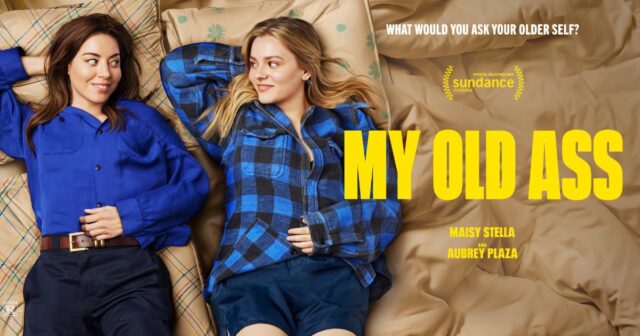Andrew Garfield and Florence Pugh Shine in the Button-Pushing ‘We Live in Time’

After many years of bathing in the most egregious clichés and emotional trappings, the romantic drama desperately needs reinvention. Look no further than director John Crowley, who made a potential solution to a decaying genre with We Live in Time, a clichéd romantic story told in a scattershot, non-linear narrative. Its structure is highly communicative, too, juxtaposing moments of high-spirited joy and reward with devastating sorrow, a primer for audiences on the complicated mess life is. It often rewards, but most of the time, it never goes how we want it to. Crowley immediately gives us a taste of how he shapes a narrative that begins with a crushing diagnosis for Almut (Florence Pugh), which quickly shifts to her meet-cute with Tobias (Andrew Garfield).
Well, it’s not ‘cute’ because Almut accidentally hit Tobias with her car after he ran to get some working pens to sign his divorce papers (oh yeah, that kind of movie). The two have an insatiable chemistry right from the get-go, but keep it at a distance for a while until it starts to get more serious. They’ve fallen madly in love with each other, which we see through fleeting vignettes of their highs (after many impossible tries, Almut is pregnant with her first child) and lows (Almut’s cancer has returned and is more aggressive).
This approach makes sense. Life is, after all, a series of fleeting memories. When we’re close to the end, our story flashes back in fragmented ways. We remember some of our purest, most joyful moments but also can’t bear the pain of our darkest, saddest days. The logical juxtaposition of both joy and sorrow works in isolation because remembering the best (and worst) parts of a romance is not a clear-cut, linear thing. Even when living an everyday, healthy life, we sometimes get flashes of moments that occurred many years ago, as if our repressed memories have suddenly returned to remind us of our greatest achievements and moments we would want to put in the rearview mirror and never think of again.
We Live in Time contains two great lead performances
But our mind doesn’t work like this, and it’s how Crowley and editor Justine Wright attempt to smartly reinvent the romantic drama after decades of linear lustful passion turned into tragedy by way of Nicholas Sparks, who has completely tarnished the genre, in both literature and film, for the worse. We Live in Time certainly possesses some mawkish Nicholas Sparks qualities, from its clinical, unimpressive cinematography by Stewart Bentley and a story that feels all too familiar for the subgenre.
However, these shortcomings are elevated by two emotionally impactful turns from Florence Pugh and Andrew Garfield, who respectively bring to life some of the best works of their career. Garfield, in particular, is a magnifying emotional force who deftly represents the renewed pleasures of finding love after his last marriage did not end well and the crushing devastation of a cancer diagnosis, potentially altering his life for the worse. There’s an impeccable scene occurring right at the top of the movie where Almut confides in Tobias that she does not know if she would want to go into treatment again and would rather spend the following months of her life making the most of her remaining time than suffering from the effects of chemotherapy that may or may not work.
We don’t get Tobias’ answer to Almut’s plight just yet because Wright cuts to something else, but it eventually repurposes how he perceived the love of his life until that time. As calculated as one might be in how they should live their lives, there will eventually be unexpected surprises that will often be positive but will also throw us to a point of no return. Tobias is not ready to lose Almut, especially after having a child, while she is at peace with wanting to accomplish at least one more thing in her storied culinary career before hanging it all up.

This A24 film’s approach to the story is often manipulative
This push-pull between wanting to hold on to the finite time we have and fighting for the family you now have is at the heart of We Live in Time’s approach, showcasing the creation of that family and the battle between wanting to keep it as long as possible and be there for your children, or surrendering to your body. Unfortunately, this gives Crowley and Wright leeway to frequently manipulate the audience into crying, which often makes what could be a naturally moving story into an egregious display of button-pushing.
One such juxtaposition between the happy and sad, meant to coax the audience into crying, occurs twofold, starting with an elaborately hilarious but wholly rewarding pregnancy scene inside a petrol station bathroom. This leads to some ridiculous, over-the-top physical comedy, but it’s also the perfect showcase for Garfield and Pugh’s more charming acting qualities. They not only have to sell the most uproarious and shocking aspects of the scene with tender feelings and immediacy. Once the baby is born and Almut drives away in an ambulance truck, the movie then cuts to the medical diagnosis she does not want to hear. Are you crying yet?
This is one isolated example, but it occurs throughout the entire movie, which tends to exploit instead of empathize with the protagonists when depicting disease, including many scenes of vomiting, exhaustion, nosebleeds, and sharp, agonizing pain. This is a problem that has plagued how movies treat characters riddled by any physical illness, no matter what it is. Few films have treated the protagonists with the compassion they need and not have the director talk down on their condition, so the audience feels sorry for them, with pity.
We Live in Time does not escape these trappings, and its non-linear narrative quickly reveals the clichés it sadly treads in, unabashedly manipulating the audience into crying with no real sense of care at the gravity of the situations Crowley wants to demonstrate on screen by way of Garfield and Pugh. Garfield is far stronger than the Little Women actress because his character is fully developed, while Almut’s illness boxes her in the most abhorrent tropes possible, with little to no humanity beyond her diagnosis.
It ultimately removes the palpable, textured connection they had in the movie’s most joyful moments because she is only used as an emotional device to get the audience to shed tears. Perhaps it will work for some, but it didn’t work for me, even after losing many loved ones to this horrible disease. I could perceive how dishonest Crowley’s techniques are and how they would rather demonize cancer instead of giving Almut the agency she deserves as someone who is not only grappling with her newfound condition but in making the limited time she now has count in her career and personal life.
Final thoughts on We Live in Time
In its final scene, Almut implicitly questions herself if her life was well-lived, represented in Florence Pugh’s facial expression of pure desolation as she looks at Tobias and her daughter, knowing she will leave them behind. It’s the only moment where Crowley gives Almut agency and a well-rounded story that represents the best – and worst – parts of being human. Life is complicated, and it will never go our way. However, there are ways to beautifully remind us of this fact instead of revealing to the audience you will manipulate them in the hopes they cry. There’s no natural, flowing emotional arc here – it’s all artificial, even if Garfield and Pugh do rock-solid work here.
Because of this, the aesthetic approach of We Live in Time automatically removes the ounces of sincerity it might have had if Crowley had taken a linear approach. Its cancer sections would still be manipulative, but not as bad as they currently are with this ridiculous technical exercise in button-pushing. If you’d like to compare and contrast with a movie that depicts cancer with the sensitivity and care it should be treated, see Joachim Trier’s The Worst Person in the World. Then, watch, We Live in Time. See the immediate difference. It won’t take long for you to realize it.
We Live in Time releases in select theaters on October 11th and will expand nationwide on October 18th. Are you going to watch this movie soon? Let us know what you think on social media @mycosmiccircus.
Heartstopper Reigns Supreme in Emotional and Heavy Season 3
My Old Ass is a Coming of Age Story with a Sci-Fi Twist




